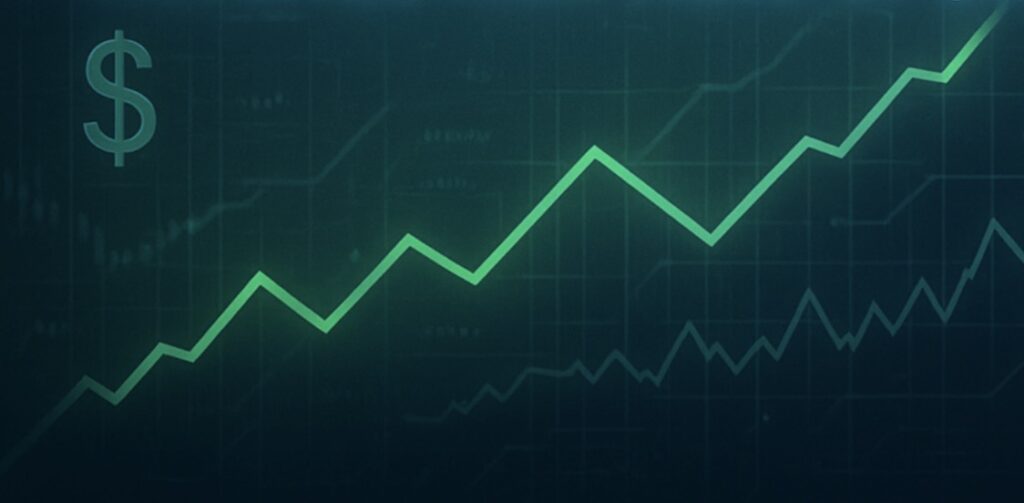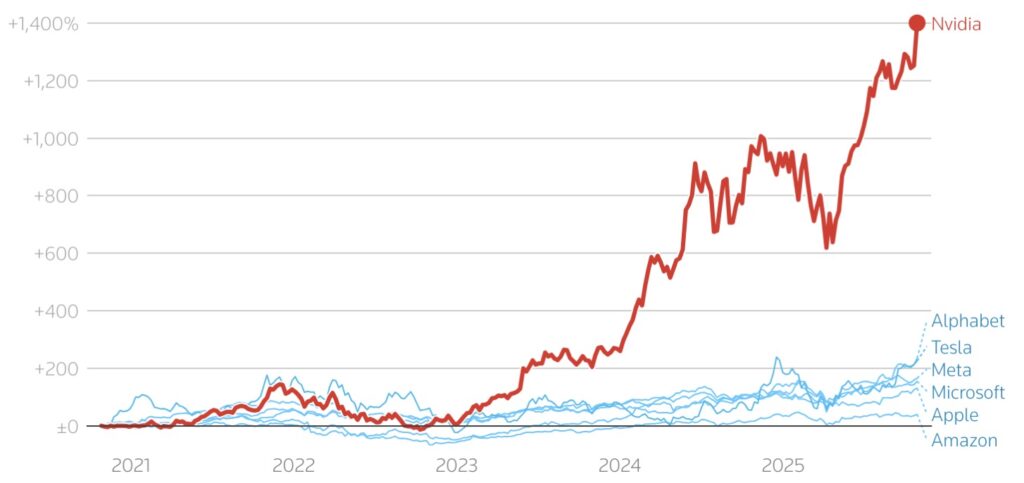What do bubbles do? As investor confidence in artificial intelligence wavers, Silicon Valley giants are losing billions, signaling deeper economic woes.
- Massive Market Sell-Off: Over $1 trillion in stock value has evaporated from AI-heavy tech companies like Nvidia, Meta, Oracle, and Palantir in just one week, marking Wall Street’s worst slump since the early days of the Trump era.
- AI Hype Meets Reality: Companies pouring billions into AI infrastructure, such as Microsoft’s $35 billion quarterly spend, are facing skepticism as profits remain elusive, with even niche players like Sweetgreen abandoning their tech dreams.
- Broader Economic Turmoil: This tech downturn coincides with rising job losses, a prolonged government shutdown, and plummeting consumer sentiment, painting a picture of an economy in distress despite claims of a “Golden Age.”
In the fast-paced world of Silicon Valley, where innovation often feels like alchemy, the shine is starting to fade from artificial intelligence. What began as a euphoric rush into generative AI—promising everything from smarter chatbots to automated everything—now appears to be hitting a wall of investor skepticism. Over the past week, a staggering $1 trillion in market value has been wiped out from some of the industry’s heaviest hitters, including Oracle, Meta, Palantir, and Nvidia. This isn’t just a blip; the Financial Times has dubbed it Wall Street’s worst week since what they wryly call Trump’s “liberation day,” highlighting a growing unease that the AI boom might be more bubble than breakthrough.
The pain isn’t limited to the tech titans who’ve bet big on AI. Take Sweetgreen, the salad chain that’s tried to reinvent itself as a tech-forward automation powerhouse, complete with AI and robotic experiments. Their vision of salads served by robots has soured; the company recently offloaded its robotics division to Wonder, and its stock has been decimated over the last year. It’s a stark reminder that AI’s allure isn’t foolproof—even for businesses outside the core tech sphere. Then there’s Microsoft, the behemoth that’s poured nearly $35 billion into capital expenditures in its latest quarter alone, much of it funneled into AI infrastructure like its Azure cloud services. Despite some bright spots in their earnings report, such as stronger-than-expected Azure growth, the stock has tumbled 8.6% over eight straight losing days, erasing about $350 billion in value. Bloomberg points out this is Microsoft’s worst streak since 2011, when it endured nine consecutive down days. At the core of this slide is a simple question: Where are the profits? Wall Street is growing wary of the enormous costs of building AI systems without clear, tangible returns, leading to a reevaluation of whether the hype matches the reality.
This tech stock meltdown doesn’t exist in a vacuum—it’s intertwined with a broader economic malaise that’s making headlines for all the wrong reasons. With the U.S. government shutdown dragging on for over a month, official economic data is scarce, but unofficial indicators are flashing red. A report from Challenger, Gray & Christmas reveals that October saw the highest job losses since 2003, with the tech sector leading the charge. Amazon alone shed 14,000 positions, underscoring how even the giants are tightening belts amid uncertainty. Consumer sentiment, as measured by the University of Michigan’s monthly survey, has plunged to some of its lowest levels ever. Joanne Hsu, the survey’s director, notes that worries about the shutdown’s ripple effects are widespread, cutting across age, income, and political lines. It’s a far cry from the narrative of the “greatest economy ever”—instead, we’re grappling with scarce jobs, skyrocketing costs, and a pervasive sense of fear that’s permeating everyday life.
From a wider lens, this moment feels like a reckoning for the AI gold rush. We’ve seen similar cycles before: the dot-com bubble of the early 2000s, where internet dreams outpaced practical value, or the more recent crypto craze that promised decentralization but delivered volatility. AI’s promise is undeniable—tools like generative models could revolutionize industries from healthcare to entertainment—but the infrastructure demands are immense, requiring vast data centers, energy resources, and capital that not every company can sustain. Microsoft’s Azure woes highlight how even leaders are struggling to monetize these investments quickly enough to satisfy shareholders. Meanwhile, smaller players like Sweetgreen serve as cautionary tales, showing that slapping “AI” on your business model doesn’t guarantee success; it can sometimes lead to costly detours.
This skepticism could be a healthy correction, forcing companies to focus on sustainable AI applications rather than speculative bets. Regulators are watching closely, with calls for oversight on AI’s energy consumption and ethical implications growing louder. For investors, it’s a wake-up call to diversify beyond the tech darlings. And for the average person? It’s a reminder that behind the buzzwords, economic stability hinges on real-world results, not just digital dreams. As we navigate this so-called “Golden Age” of innovation, one thing is clear: when bubbles burst, the fallout can be trillion-dollar messy. But perhaps this dip will pave the way for a more grounded, profitable future in tech.


